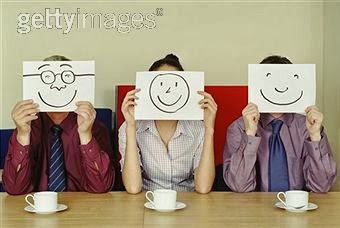Just like our emotions and thoughts can affect our behaviour (when we are sad we cry, and when we are happy we smile and laugh), our behaviour can affect our emotions and thoughts. I am sure that you have even experienced it before without necessarily being aware of it. Have you ever tried to act as a happy person and to make an effort to smile more at a time when you were feeling a bit down? If you have, you may as well have noticed that you probably felt happier and more positive after a little while. In the same way, if you are having a conversation with someone and you cross your arms on your chest your body language will not only communicate to the other person that you are shutting yourself off but it will also make YOU feel more negative about your conversation (if you don’t believe me, try it!).
In his book 59 Seconds: Think a little, change a lot, Professor Richard Wiseman says: “Get people to behave a certain way and you cause them to feel certain emotions and have certain thoughts[1].”
Some researchers have carried out tests to show evidence of this phenomenon. One of those tests for example, consists in showing a group of people items moving vertically and others moving horizontally on a screen. The participants are then asked which items they preferred. Unaware of what has been going on during the tests, most participants reply that they preferred vertically-moving items. What has actually motivated their choice is that vertically-moving items have made them nod, making them say “yes”, whereas horizontally-moving items have made them move their head from side to side therefore making them say “no”.
In another test that was carried out by Fritz Strack (a professor of Social Psychology) and his colleagues in the 1980s, two groups of people were told that they were going to watch a cartoon. Both groups were given a pencil. People in group 1 were asked to hold the pencil in between their teeth without making their lips touch (which forced them to smile); people in group 2 were asked to support the end of the pencil with their lips but not their teeth (which forced them to frown). At the end of the cartoon it was noticed that the participants in group 1 had enjoyed the cartoon more and had found it funnier than people in group 2, showing that the participants had experienced the emotions associated with their expressions. So it would seem that we do indeed have a better impression of things when we smile (even if this smile is forced).
Is the same thing happening when we speak then?
When we speak we force our face into displaying a variety of emotions. Not that we really have the choice: to be able to pronounce certain sounds we have to open our mouths more or less wide, move our cheeks, purse our lips, etc. and as a result it looks like we are smiling, or pouting, or who knows what else? Thus, for instance, we will have to smile to pronounce words like “happy”, “family”, “sneeze” and to say brands like Ovaltine, KFC’s Complete Treat, Sunny Delight (a.k.a. Sunny D), Vaseline. The question then is to know whether or not we keep a better impression of those names because they literally make us smile when we say them, and whether we are happier and more positive when we say them than when we say Oreo, Braun or Walkers for example.
To me there is a lesson to learn from this: marketing people should probably give some thought to this too as it seems that if you make your customers smile (or say “yes”), they may be happy to come back to your brand.
[1] R. Wiseman (2009). ‘Happiness is a pencil’. 59 Seconds: Think a little, change a lot, pages 32-33
